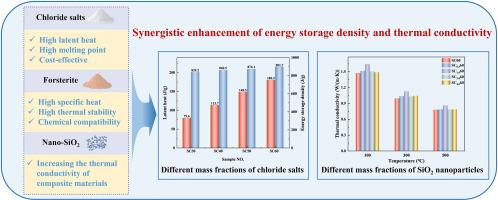用于高温储热的新型高能量储存密度的森林石/氯盐复合材料
IF 6.3
2区 材料科学
Q2 ENERGY & FUELS
引用次数: 0
摘要
复合相变材料在高温储热和余热回收方面具有重要的应用价值,但其较差的储能密度和导热性限制了其实际应用。本研究提出了以SiO2纳米颗粒修饰的KCl-NaCl为相变材料,以高比热的forsterite为基体材料对复合材料进行同步增强的方法。结果表明:复合材料具有良好的化学相容性,适当的氯盐含量和成型压力有利于增强复合材料的致密性,同时提高复合材料的热力学性能。其中,氯盐含量为60 wt%、成型压力为40 MPa的复合材料性能最佳,100 ~ 800℃时的储能密度为901.7 J/g,潜热为180.5 J/g, 100 ~ 500℃时的导热系数为0.78 ~ 1.47 W/(m·K),抗压强度为41.5 MPa。值得注意的是,添加1.0 wt% SiO2纳米颗粒可形成针状纳米结构,增强了复合材料的导热性和储能密度。经过500次热循环后,复合材料表现出良好的化学稳定性,同时由于在橄榄石和氯化物之间形成中间层,复合材料的导热性增强。这表明复合材料在热能储存方面具有广阔的应用前景。本文章由计算机程序翻译,如有差异,请以英文原文为准。

Novel forsterite/chloride salts composite materials with high energy storage density for high temperature thermal energy storage
Composite phase change materials are particularly valuable for high temperature thermal energy storage and waste heat recovery, but the poor energy storage density and thermal conductivity limit their practical applications. Herein, this study proposed a concurrent enhancement of composite materials by utilizing SiO2 nanoparticles-decorated KCl-NaCl as phase change materials and forsterite with high specific heat as matrix materials. The results showed that forsterite and chloride salts exhibited excellent chemical compatibility, and the appropriate content of chloride salts and suitable molding pressure were beneficial to enhancing the densification of composite materials while increasing their thermal and mechanical properties. Specifically, the composite materials with chloride salts content of 60 wt% and molding pressure of 40 MPa demonstrated the best performance, with an energy storage density of 901.7 J/g (100–800 °C), a latent heat of 180.5 J/g, thermal conductivity of 0.78–1.47 W/(m·K) at 100–500 °C, and a compressive strength of 41.5 MPa. Notably, the addition of 1.0 wt% SiO2 nanoparticles resulted in the formation of needle-like nanostructures, which enhanced the thermal conductivity and energy storage density of composite materials. The composite materials exhibited good chemical stability after 500 thermal cycles, accompanied by an enhancement in thermal conductivity due to the formation of middle layer between forsterite and chloride salts. This suggests a promising potential for composite materials in thermal energy storage applications.
求助全文
通过发布文献求助,成功后即可免费获取论文全文。
去求助
来源期刊

Solar Energy Materials and Solar Cells
工程技术-材料科学:综合
CiteScore
12.60
自引率
11.60%
发文量
513
审稿时长
47 days
期刊介绍:
Solar Energy Materials & Solar Cells is intended as a vehicle for the dissemination of research results on materials science and technology related to photovoltaic, photothermal and photoelectrochemical solar energy conversion. Materials science is taken in the broadest possible sense and encompasses physics, chemistry, optics, materials fabrication and analysis for all types of materials.
 求助内容:
求助内容: 应助结果提醒方式:
应助结果提醒方式:


